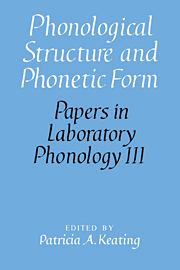Book contents
- Frontmatter
- Contents
- List of contributors
- Acknowledgments
- 1 Introduction
- I Intonation
- 2 Articulatory evidence for differentiating stress categories
- 3 “Stress shift” as early placement of pitch accents: a comment on Beckman and Edwards
- 4 Constraints on the gradient variability of pitch range, or, Pitch level 4 lives!
- 5 “Gesture” in prosody: comments on the paper by Ladd
- 6 What is the smallest prosodic domain?
- 7 The segment as smallest prosodic element: a curious hypothesis
- II Syllables
- III Feature Theory
- IV Phonetic Output
- Index of subjects
- Index of names
7 - The segment as smallest prosodic element: a curious hypothesis
Published online by Cambridge University Press: 26 February 2010
- Frontmatter
- Contents
- List of contributors
- Acknowledgments
- 1 Introduction
- I Intonation
- 2 Articulatory evidence for differentiating stress categories
- 3 “Stress shift” as early placement of pitch accents: a comment on Beckman and Edwards
- 4 Constraints on the gradient variability of pitch range, or, Pitch level 4 lives!
- 5 “Gesture” in prosody: comments on the paper by Ladd
- 6 What is the smallest prosodic domain?
- 7 The segment as smallest prosodic element: a curious hypothesis
- II Syllables
- III Feature Theory
- IV Phonetic Output
- Index of subjects
- Index of names
Summary
In his original contribution, Van Heuven challenges the traditional view that accent is a property of the syllable or word. He suggests instead that accent is a segmental property. In a perception experiment, words produced under different focus conditions were played back to determine if listeners could tell under which focus condition a particular word had been produced. Narrow focus was placed on an individual segment of the target word. The results of the perception experiment constitute a significant finding in that listeners performed this task at better than chance level. However, when it comes to determining the kind of acoustic information on which listeners base their decision, the situation becomes more complex.
In a subsequent production study, the acoustic characteristics of segments of target words were analyzed. Surprisingly, the cues that are often thought to indicate accent or focus, such as duration and intensity, did not play a significant role. Instead, it turned out that pitch was the only cue to segmental contrast. Specifically, there seemed to be an inverse relation between the position of the pitch peak and the position of the focused segment. For a CVC word, the pitch peak occurred relatively late when the initial consonant was in focus, at an intermediate position when the vowel was in focus, and relatively early when the final consonant was in focus.
Evidence for the claim that accent is a segmental property is entangled in suprasegmental variables. Acoustically, segmental contrast as studied in this experiment is signaled by properties of the pitch contour over the entire word containing the segment, not by a property restricted to that segment.
- Type
- Chapter
- Information
- Phonological Structure and Phonetic Form , pp. 99 - 104Publisher: Cambridge University PressPrint publication year: 1994

